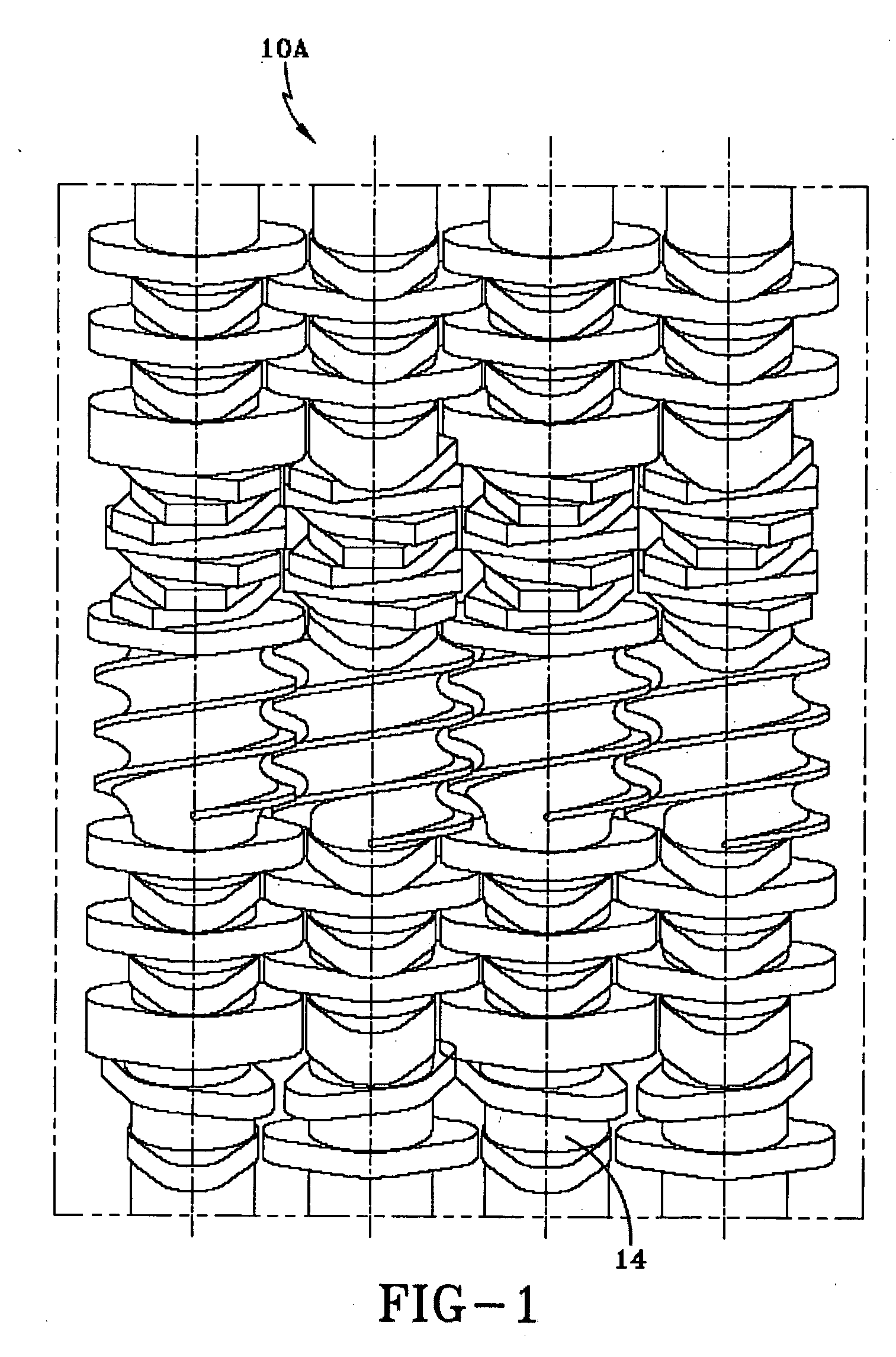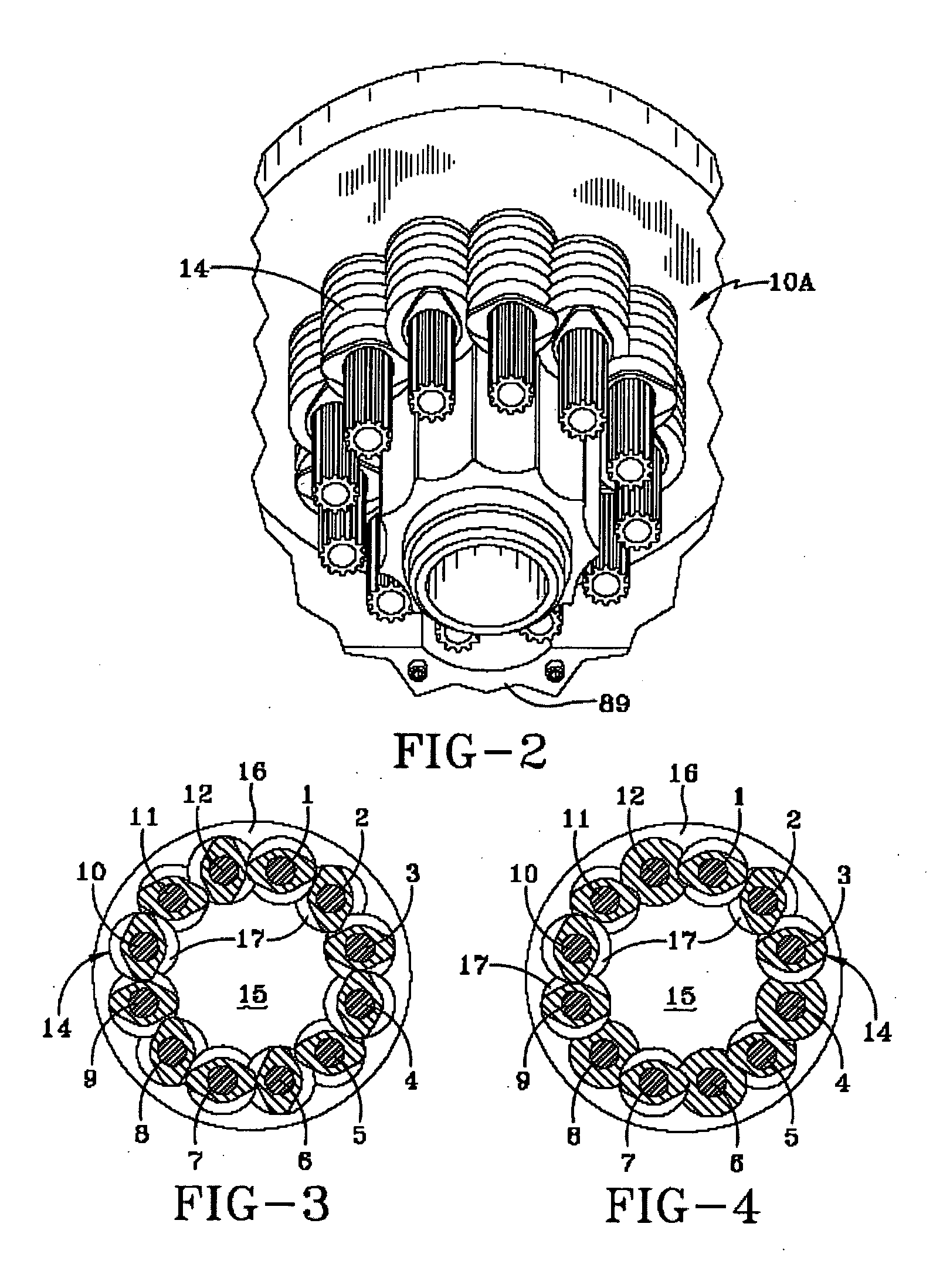Preparation of thermoplastic elastomers by dynamic vulcanization in multi-screw extruders
- Summary
- Abstract
- Description
- Claims
- Application Information
AI Technical Summary
Benefits of technology
Problems solved by technology
Method used
Image
Examples
example 1
[0137] In this EXAMPLE, properties of thermoplastic vulcanizates made using screw profiles A and B in a ring extruder were examined. Four experimental thermoplastic vulcanizates (TPVs) were made using screw profile A, and three TPVs were made using screw profile B. For each TPV, a phenolic resin cure was used. The experimental compositions were compared with a comparative example product made by processing in a twin screw extruder.
[0138] Isotactic polypropylene (PP) was used as the thermoplastic polymer. In this and the following examples, unless otherwise specified, the PP used is high molecular weight F008F PP from Sunoco Inc. (Chemicals) or 5341 PP from ExxonMobil Chemical Co., or low molecular weight F180A PP from Sunoco Inc. (Chemicals), or a blend of two or all three of the polypropylenes. EPDM V3666 from ExxonMobil Chemical Co. was used as the rubber component.
[0139] In this and the following examples, unless otherwise specified, ‘phenolic resin cure’ refers to phenolic res...
example 2
[0157] This example shows the difference in properties resulting by varying the amount of curative used during processing. In this example, resin diluted in process oil was added at barrel segment 23 for all runs, but the amount of resin was varied. The same materials described in EXAMPLE 1 were used. Screw profile B as used in produing this example. The TPV described is a carbon black reinforced composition, and 9.6 phr carbon black was used. Each of the compositions included 41.5 phr PP and 142.7 phr oil. The PP comprised 29.3 wt. % based upon the weight of thermoplastic plus cross-linked rubber. All samples were run at 560 RPM. The compositions varied slightly, as indicated in Table 2.
[0158] The formulations for the invention and comparative examples comprising the following (in phr): PP=27.08, EPDM rubber (V3666, ExxonMobil Chem. Co.)=175 (of which 75 phr was extender oil), zinc oxide=2.0, stannuous chloride=1.26, process oil=62.4, HRJ-14247A=7.58 (of which 5.31 phr was diluent...
example 3
[0161] In this example, the effect of extruder RPM is shown. The formulation were the same as in EXAMPLE 1. In the example, all samples had a 200 Kg / Hr feed rate, and the weight percentage of PP used was 25.4%. All other parameters for the experimental TPVs were the same. The A screw profile was used, and resin diluted in process oil was injected at barrel segment 25, and in processing, additional oil was added up and down stream of the addition of the curatives. The data in table 3 indicates that lower rpms, and probably the resultant increased residence time, causes an improvement in physical properties.
TABLE 3Ex. #Comp. I121314RPM300400560840Hard(Sh A)59.857.954.553.6WtGn %106.999.5113165.5Tension Set %NA7.57.510UTS(psi / MPa)717 / 4.94691 / 4.76613 / 4.23458 / 3.16M100(psi / MPa)268 / 1.85254 / 1.75222 / 1.53201 / 1.39UE %415439398462ESR102117136190SpE0.3580.2100.2420.306
[0162] Specific Energy was increased at 840 RPM, but was still significantly less than the twin screw extruded comparative exam...
PUM
| Property | Measurement | Unit |
|---|---|---|
| Fraction | aaaaa | aaaaa |
| Fraction | aaaaa | aaaaa |
| Fraction | aaaaa | aaaaa |
Abstract
Description
Claims
Application Information
 Login to View More
Login to View More - R&D
- Intellectual Property
- Life Sciences
- Materials
- Tech Scout
- Unparalleled Data Quality
- Higher Quality Content
- 60% Fewer Hallucinations
Browse by: Latest US Patents, China's latest patents, Technical Efficacy Thesaurus, Application Domain, Technology Topic, Popular Technical Reports.
© 2025 PatSnap. All rights reserved.Legal|Privacy policy|Modern Slavery Act Transparency Statement|Sitemap|About US| Contact US: help@patsnap.com



